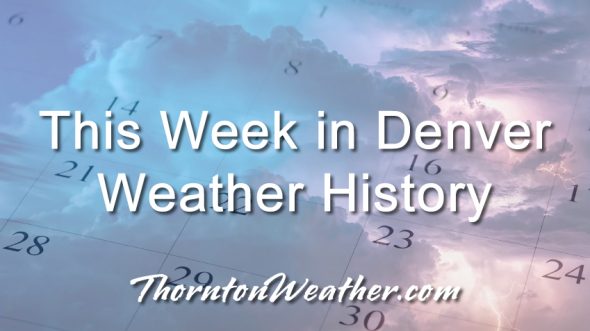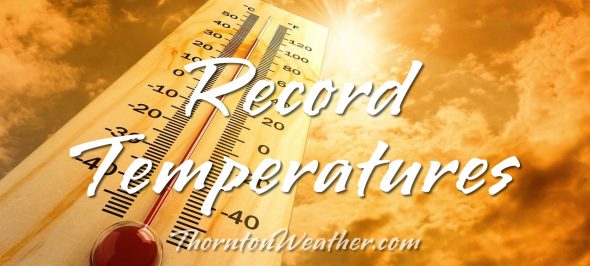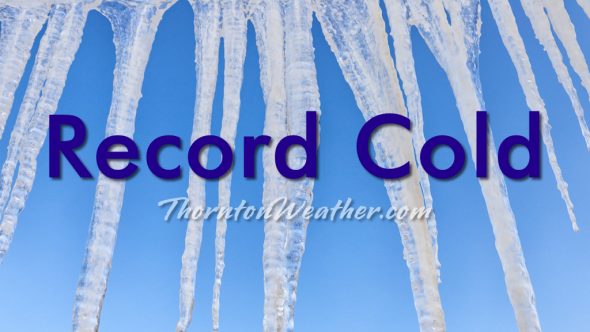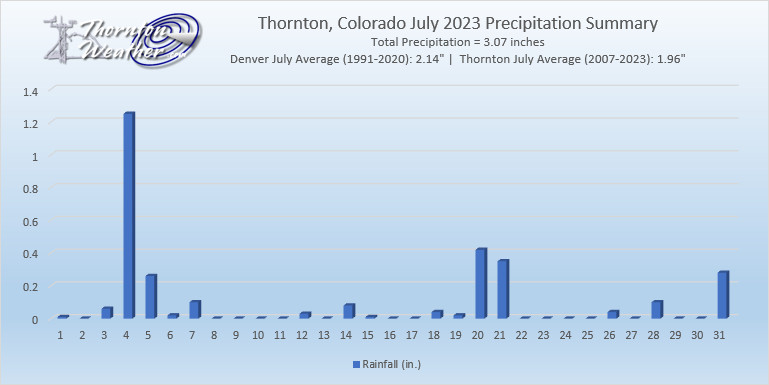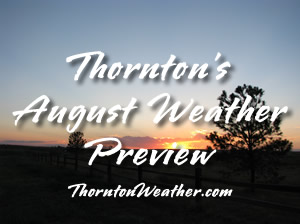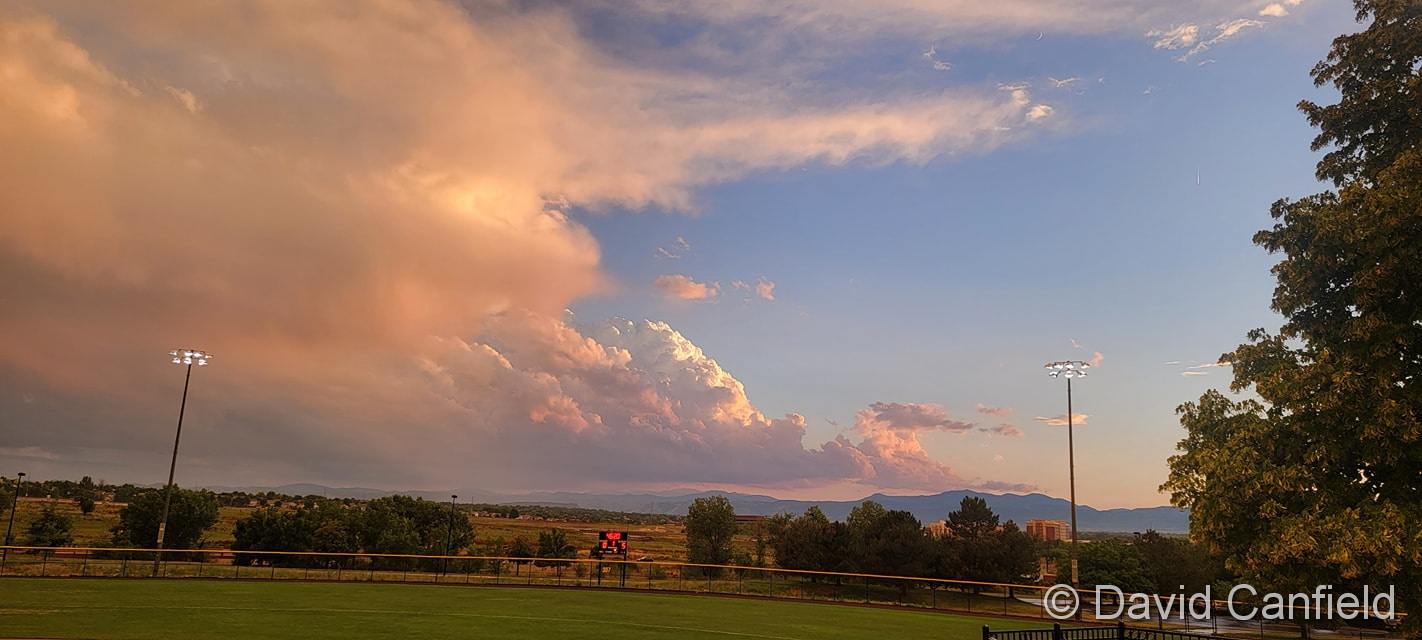Denver’s weather is not often boring. Lightning, hail, tornadoes and even swarms of grasshoppers have made appearances this week in Denver weather history.
From the National Weather Service:
19-30
In 1875…grasshoppers appeared in great numbers at 10:00 am on the 19th. Thousands landed on the ground. The streets were literally covered with them. Swarms of grasshoppers were seen on each day. All gardens in the city were devastated…and in the countryside the grasshoppers were very destructive to ripened grain. On the 30th the grasshoppers were so numerous as to almost darken the sun.
20
In 1980…winds to 55 to 60 mph were recorded in south Boulder.
In 1982…strong thunderstorm winds blasted the Jefferson County Airport near Broomfield…causing an estimated 3 million dollars in damage. At least 5 hangars and 15 airplanes were damaged…many seriously; one hangar was completely destroyed. Torrential rains accompanied the winds. Heavy rains also dumped on Boulder where 1.65 inches fell in just 15 minutes…causing street flooding. Wind gusts to 72 mph were recorded in Boulder. Over half an inch of rain fell in just 5 minutes in Littleton where two homes were struck by lightning. Lightning also struck a house in Arvada where over an inch of rain sent Ralston Creek over its banks. Strong winds accompanied the storms.
In 1984…slow moving thunderstorms dumped 1.25 inches of rain in Evergreen…causing street flooding. A half inch of rain fell in just 18 minutes in southeast Denver. Littleton and Boulder were also drenched with about an inch of rain. Rainfall totaled 0.92 inch at Stapleton International Airport.
In 2001…severe thunderstorms produced damaging winds and large hail across metro Denver. Hail as large 1 inch in diameter fell in Aurora near Cherry Creek. Strong thunderstorm winds gusting as high as 58 mph blew the roof from a building between Thornton and Denver and toppled several trees in Denver. One tree landed on a mail truck. Other thunderstorm winds were clocked to 60 mph near Parker… 62 mph in Broomfield…and 61 mph at Denver International Airport.
In 2006…a tornado (f0) touched down near Bennett…but caused no reported damage.
In 2013…severe thunderstorms pounded the southern Denver suburbs and other parts of the Front Range. In Jefferson County…water rescues were reported for some people in stranded cars. In the Ken Caryl area…large hail from one inch to 1 3/4 inches in diameter was reported. On West Chatfield Avenue in Jefferson County…hail runoff gathered six inches deep in spots and “hail plows” were sent out to clear some streets. Hail up to one inch in diameter was also reported near Castle Rock.
21
In 1876…heavy thunderstorm rain and hail struck the city. Hail stones as large as partridge eggs accumulated to a depth of 1 1/2 feet over eastern portions of the city. The heavy rainfall flooded streets and gutters. However… No significant damage was reported. Rainfall totaled 0.85 inch in central Denver.
In 1903…a thunderstorm produced west winds sustained to 42 mph with gusts to 48 mph.
In 1957…heavy thunderstorm rainfall and hail over the bear creek basin flooded portions of State Highway 8 in and near Morrison. There was also minor property damage in Morrison.
In 1995…a 68-year-old woman was struck by lightning while standing near a tree in Brighton.
In 2006…a severe thunderstorm produced 7/8 inch diameter hail in Franktown.
In 2019…severe thunderstorms produced hail up to 1 inch in diameter in parts of Arapahoe…Denver and Jefferson counties. Heavy rain and flash flooding…close to 2 inches in one hour…also accompanied the nearly stationary storms. In Denver…flash flooding caused several vehicles to be stranded at Martin Luther King Blvd and Dahlia Street. Highway 6 near Federal Blvd also flooded. Standing water up to 3 feet deep occurred in Park Hill. Lastly…water made its way into buildings north of Interstate 70. At Denver International Airport…just a trace of rainfall was recorded.
22
In 1898…an apparent thunderstorm produced southwest sustained winds to 40 mph with gusts to 43 mph.
In 1903…a late afternoon thunderstorm produced rain…hail… And east winds sustained to 40 mph with gusts to 44 mph.
In 1904…the lowest recorded temperature in August…40 degrees…occurred. The same temperature also occurred on three consecutive days…August 24…25…and 26 in 1910.
In 1965…heavy rain and hail caused some damage from flooding over northern Douglas County from Castle Rock to Franktown.
In 1981…thunderstorms moved across metro Denver. At least 5 funnel cloud sightings were reported. Funnel clouds were seen at 96th Ave. and Sheridan Blvd. And at 92nd Ave. and Federal Blvd. in Westminster and 7 miles north of Stapleton International Airport. Lightning injured two people in Boulder. A quarter inch of rain fell in just 5 minutes in Brighton. Up to 3/4 inch of rain doused Parker in 30 minutes.
In 1983…3/4 inch diameter hail was reported at Kittredge… Along with 0.60 inch of rain in 25 minutes.
In 1984…a thunderstorm dumped 4 inches of rain on Brighton in 90 minutes…causing extensive street flooding in the downtown area.
In 1987…over an inch of rain fell in 24 hours throughout most of metro Denver. A public library suffered water damage to the ceiling…carpet…and a few books. Rainfall was 0.76 inch at Stapleton International Airport.
In 1990…lightning knocked out power to about 2500 homes in Lakewood for about an hour.
In 1991…National Weather Service personnel at Stapleton International Airport sighted an apparent tornado briefly on the ground 3 miles west-northwest of the airport. No damage was reported.
In 1995…lightning struck 3 electrical power substations in Louisville. Residences of more than 4500 people were without power from 30 minutes to more than an hour.
In 1996…between 1 and 3 inches of rain fell across metro Denver. As a result…several low lying areas were flooded. A bicyclist was swept into a fast moving creek when he tried to cross a flooded bike path. The man was washed downstream about 15 feet before getting snagged by a tree stump. He and a man who tried to rescue him received minor injuries. The heavy rain caused numerous power outages…false fire alarms…and traffic accidents. In Lakewood…telephone service to around 60 thousand residents was knocked out when a switching center was flooded. Funnel clouds were sighted near Chatfield Reservoir and Highlands Ranch.
In 2000…lightning sparked a blaze which gutted a 10-unit apartment building in Highlands Ranch. Twenty-eight people were left homeless. Damage was estimated at 2 million dollars.
In 2007…severe thunderstorms produced large hail…up to 1 1/4 inches in diameter…in the vicinities of Castle Rock… Elizabeth and Franktown.
In 2013…flash flooding occurred in central Douglas County with numerous road closures reported. One of the closures occurred at the Tomah Road exit along I-25…south of Castle Rock. The closure backed up all I-25 the way to Castle Rock. At Denver International Airport…1.94 inches of precipitation was recorded…which set a new record rainfall for the date. The old record was 0.75 inches… set back in 1953.
22-24
In 1987…some locations in metro Denver had a total 3-day rainfall of 2 to 4 inches. Rainfall totaled 0.96 inch at Stapleton International Airport.
23
In 1900…northwest winds were sustained to 42 mph with gusts to 49 mph.
In 1921…a thunderstorm cloudburst produced 2.20 inches of rainfall in an hour over downtown Denver. This is the greatest 1 hour rainfall on record at the official observing site in the city. Precipitation totaled 2.93 inches…which is the greatest calendar day precipitation ever recorded in August.
In 1941…one man was killed by lightning about 2 miles from the official weather station in downtown Denver.
In 1962…a home near Boulder was destroyed by a lightning- caused fire.
In 1968…strong winds buffeted Boulder briefly during the early morning hours. At the National Center for Atmospheric Research…winds averaged 55 mph with gusts to 85 mph. Damage was minor. Northwest winds gusted to 31 mph at Stapleton International Airport.
In 1977…lightning damaged at least 6 homes in Aurora.
In 2008…a landspout touched down near Westcreek in Douglas County. One man was seriously injured when he tried to escaped several falling trees in his ATV. One of the trees struck his back and broke two vertebra. Another camper narrowly escaped injury. Seconds after he back up his truck…a tree came down where it had been parked.
In 2019…a severe thunderstorm produced large hail…up to 2 1/2 inches in diameter 5 miles west of Byers. Hail up to 1 3/4 inches in diameter was reported near Bennett.
24
In 1880…a thunderstorm produced vivid lightning and heavy rainfall…which caused flooding over the eastern part of the city including the brick yards. There was no rainfall recorded in downtown Denver.
In 1910…an apparent dry cold front caused a remarkable drop in temperature. From 3:00 pm until midnight the temperature fell from a high of 93 degrees to a low of 40 degrees. Northeast winds were sustained to 44 mph during the late afternoon.
In 1946…heavy rain near Idledale caused flooding on bear creek at Morrison…which resulted in one death when a woman was swept from her stranded car and drowned.
In 1973…strong winds blew down a few power lines and hail up to 3/4 inch diameter fell in southeast Aurora.
In 1984…heavy rain hit the south Denver area. Over an inch fell in less than an hour at both Castle Rock and Sedalia.
In 1992…heavy rains caused flash flooding across parts of metro Denver. Rainfall amounts of 1 to 3 inches fell with the hardest hit areas being the southwest and central parts of metro Denver. Bear Creek rose above bankfull near Idledale with flood waters moving into southwest metro Denver. Mud and rock slides along Colorado highway 74 west of Morrison were reported. The confluence of Cherry Creek and the South Platte River in downtown Denver also went out of its banks…flooding bike paths. Rainfall totaled 1.98 inches at Stapleton International Airport where light to moderate rain fell most of the day. Heavy rain and fog briefly reduced the surface visibility to 1 1/2 miles. The temperature climbed to a high of only 58 degrees…which was a record low maximum for the date.
In 2002…hail to 7/8 inch in diameter was measured in southwest Denver.
In 2008…several landspout tornadoes developed along a boundary to the southeast of the Denver metropolitan area during the Democratic National Convention. In northwest Elbert County… Minor damage was reported. The damage consisted of downed power lines…broken windows and an out building. Severe thunderstorms also produced very heavy rain and large hail… Up to one inch in diameter. In southwest Douglas County… Heavy rain caused flash flooding near the town of Westcreek. A mudslide closed State Highway 67. The road in the YMCA camp shady brook was also washed out and some bridges were damaged.
24-26
In 1910…the lowest temperature ever recorded in August…40 degrees…occurred on each of these days and on August 22… 1904. The unusually cold weather for so early in the season brought sub-freezing minimum temperatures to much of the Colorado northeastern plains.
25
In 1951…a microburst produced a southwest wind gust to 50 mph at Stapleton Airport. Only a trace of rain was observed.
In 1964…thunderstorm winds gusted to 59 mph and caused some blowing dust at Stapleton International Airport.
In 1994…lightning struck a power pole in Louisville and caused a two-hour power outage.
In 2008…an unoccupied home was struck by lightning in Aurora… Causing 75 thousand dollars in damage to the roof.
26
In 1944…one of the most destructive hailstorms in the city in a decade caused damage estimated at nearly one million dollars. The storm occurred within a period of 10 to 30 minutes…between 2:00 pm and 3:00 pm. The hail varied in size from very small to as large as 1 1/2 inches in diameter. Hail covered the ground to a depth of 5 to 6 inches in some sections of the city. Several people were cut by broken glass. The hail and heavy rain flooded underpasses to a depth of 6 feet…and the occupants of stalled autos had to be rescued. Sewers were unable to handle the sudden amount of water and water backed up and flooded a number of basements. A few first floors of buildings were flooded. The water department had a busy time replacing manhole covers that had been displaced by the water pressure. Trees were stripped…one was severely broken…and telephone lines were downed. Roofs…windows… Automobiles…awnings…and gardens were severely damaged. Flowers and gardens in some sections of the city were a total loss. Greenhouses were extensively broken with an estimated 20 carloads of glass shattered. Vegetable and truck crops in and around the city were severely shredded. The next day the American Red Cross was designated by the War Agency to grant any and all priorities needed to obtain materials and supplies to replace and repair the damage. In downtown Denver…the thunderstorm produced 0.95 inch of rain and heavy hail along with sustained northwest winds to 25 mph.
In 1961…strong winds blew in the walls of a warehouse under construction in Denver. Two workmen suffered a fractured foot and body bruises.
In 2014…two men in central Denver were struck by lightning as they sat under a tree to avoid a heavy downpour. One of the men was unconscious and had no pulse when emergency responders arrived. He was immediately taken to Denver Health was listed in critical condition. The other victim suffered less severe injuries. He was treated at the scene and hospitalized…then released a few hours later.
26-27
In 1980…two heavy thunderstorms hit Arvada and Westminster… Dumping up to 1.50 inches of rain in less than an hour. At least two streets were washed out and a number of homes and cars were damaged when a creek flooded. Three homes in Arvada sustained minor lightning damage.

